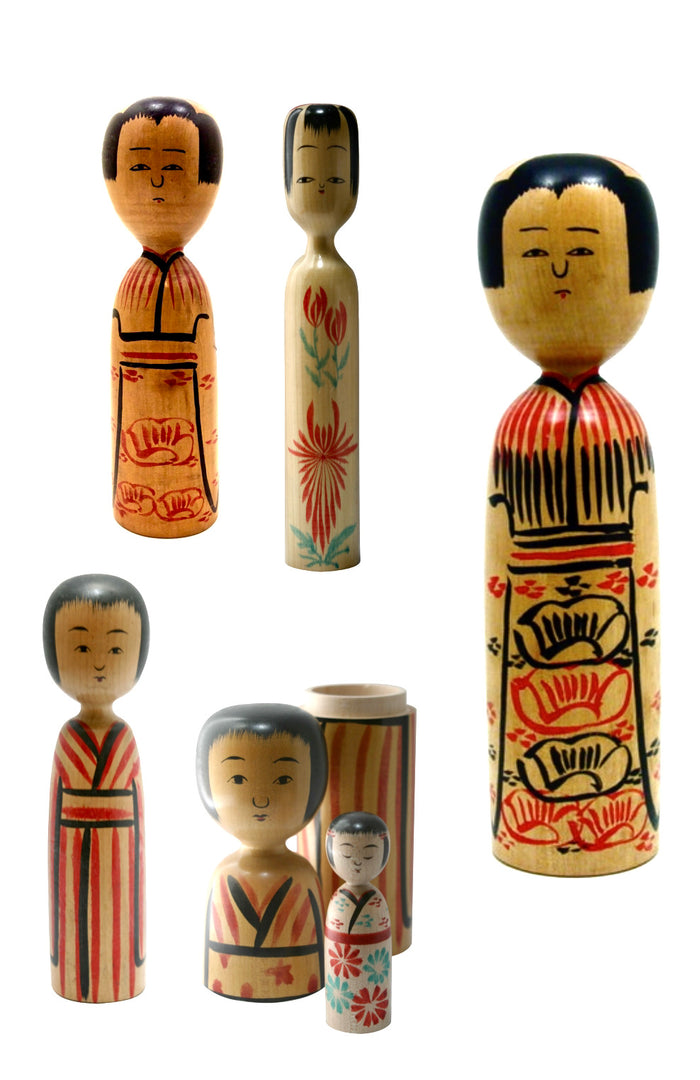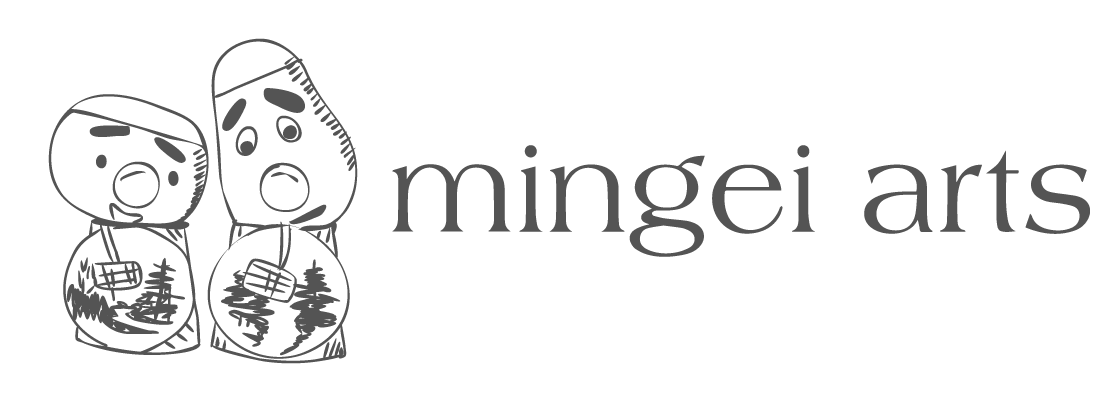Unusual Japanese Kijiyama Kokeshi Container with Child by Takahashi, Yuji
Dimensions: 9-3/4” H 0- 3-1/2”h (child)
One of the most readily recognizable of the traditional dolls is the Kijiyama type, from the region of the same name in the Akita Prefecture. The name is derived from the woodworkers (Kiji-shi), who live in the remote mountains of the Tohoku region.
Offered is a Kokeshi which was made as a gift, (Omiyage) for a daughter by a Mother who was vacationing in Northern Japan. The design emphasizes the cultural importance of Family specifically Mother and Child and was created in the early 1950s.
This exceptionally unusual treatment of a traditional doll focuses on the fact that it was made as a container in which the figure separates to show a small miniature child inside. This Kijiyama appears to have the traditional one-piece body with high shoulders. It is a two-piece construction in which the center of the figure separates. She is wearing a red and black vertical striped yukata, which some refer to as a kimono, with an apron-like element (maedare), over her base clothing. Her head was in the shape of an inverted egg, with solid black hair and bangs. She has the typical style face for this family of Kokeshi: a round nose, (Maru-Bata), and wide-open all-black eyes, (Tsubushi-me). Finally, her face is finished with a small mouth/lips in red.
NOTE: An interesting element is incorporated into the child figure. Her feathered hair and side fringes and specifically the tuft of hair on the back of the head cascading down the back has long had a social, religious, erotic, and psychological significance. For the Buddhist woman, one of the most important aspects is their hair. This long tuft of hair has the purpose of being a perch for gods and is known as the “YORISIRO” phenomenon which is a Shinto concept of “purity”.
On the back of each doll is his signature and at the right is its identification. Mr. Ogura passed in 1998 at the age of 91, (1906-1998). In his later years, the Ogura's family members would make the dolls and he would complete all the artwork on the body although this piece is one of his earliest in which he completed both the construction and graphics related to the doll. He was a very famous and popular artist for which his dolls are still very much collected and prized.
See additional writings on our website related to this subject: Under our Browse and Learn section, please refer to https://mingeiarts.com/collections/kijiyama-kei-family for full details on the history and development of this style doll. Also, see https://mingeiarts.com/blogs/celebration-of-mingei-journey-through-japan/vintage-japanese-spiritually-inspired-kokeshi-and-figures-creating-images-to-nourish-thought for thoughts on the” Yorisiro” phenomenon.
Condition: Excellent, original condition, with no fading or loss of color, with a rich chestnut hue, which adds a warm and inviting aesthetic to the piece. The doll is consistent with the age and standards of collectible Kijiyama Family dolls. All details are perfect and as crafted.

Japanese Traditional Kokeshi
Kijiyama-Kei (Family)
Prefecture: Akita
Origin:
One of the most readily recognizable traditional dolls is the Kijiyama type, from the region of the same name in the Akita Prefecture. The name is derived from the wood craftsmen (Kiji-ya), who live in the remote mountains of the Tohoku region. The actual location of Kijiyama is so remote that it was inaccessible in the harsh winter months. Many of the kokeshi makers left and settled in the less remote areas of Kawazura, now part of Inagawa-machi. Some suggest that the dignified, lonely look on the faces of Kiiyama kokeshi reflects the lonesome past of their birthplace.
Collector's note – characteristics / painting style:
Despite the slightly sad look some of these kokeshi have, they are very appealing and sought after for their well-defined style. Their elongated “inverted egg” shaped head is attached to a relatively chunky body, both of which are well proportioned. They typically have a red hair ribbon-like motif, but some can be without any hair ribbon (Okappa style), with a “bobbed” hairstyle and half or full moon bangs across the forehead. The eyes can be shut or partially closed (tsubushi-me), or fully opened, and may or may not have eyebrows. Their nose shapes are typically rounded, with small single or double-line lips. The most common motif on the body incorporates chrysanthemums, which were common in the earlier versions. Plum blossoms are seen on those dolls, which are closely associated with the Ogura family. The body usually possesses a kimono-like painted design in several distinctive patterns, suggesting an apron (maedare), over the kimono, which was incorporated later in the doll's development. Additionally, a striped overall patterned kimono-clad is seen as an alternative to the apron. Some have what is called a Kasuri pattern using a kanji symbol. Most Kijiyama dolls demonstrate the same state of being within this style of Kokeshi.

Leading Craftsmen:
Abe, Heishiro, 1929-2013, (Inagawa, Akita) - Master: Takahashi, Heijiro. No additional published information
Abe, Yoko, 1932, (Yuzaya, Akita) - Master: Abe, Heishiro. No additional published information
Honma, Isao, 1935. The third son of Shimazo and Rio Honma is a schoolteacher in Tsubakigawa, Higashinaruse Village, Ogachi District, and Akita Prefecture. His family owned forestland, so he loved woodworking from elementary school, making wooden carvings including Kokeshi, bears, and furniture. No additional published information.
Igawa, Takemitsu, 1925-2008, (Inagawa Akita) - Master: Ozeki, Kyutaro. No additional published information.
Kitayama, Kenichi - No additional published information
Koyasu, Ichigoro - No additional published information
Onodera, Masanori, 1948-2018. Kijiyama lineage, Master: Tokuichi Onodera. The eldest son of Onodera Tokuichi in Odate, Kawatsuraya, Akita Prefecture. The Onodera family had been lacquer artists in Kawatsuraya for generations. It is said that Fujimi (childhood name Umetaro), who was a lacquer artist, innovated the painting and decorating Kokeshi dolls and started the painting method of apron. After graduating from the Yuzawa Kita branch school, Masanori worked as a lacquer artist for two years and then studied woodworking for one year. He learned lathe working from his father Tokuichi. No additional published information.
Ogura, Kyutaro, 1906-1998, Grand Master (Minase, Akita) - Master: Ogura, Kyushiro. No additional published information
Ogura, Tomezo, 1909, (Inagawa, Akita) - Master Ogura, Kyushiro. No additional published information
Onodera, Juichi, 1908, (Inagawa, Akita) - Master Ogura, Keitaro. No additional published information
Sato, Hideichi, 1927, (Inagawa, Akta), Master Sato, Kaneichi. No additional published information
Shibata, Ryoji, 1944, (Inagawa, Akita)) - Master Shibata, Tetsuzo. The second son of Keijiro Ogura and Mura in Yafumae, Odate, Kawatsurē Village, Akita Prefecture, and in 1958, at the age of 15, he made a Kijiyama doll which influenced his lifetime profession throughout his life. No additional published information is available.
Suzuki, Koutaro, 1922-1989, (Inagawa, Akita) - Master Takahashi, Heijiro. No other published information.
Takahashi, Yuji, 1934 - No additional published information.
Explore & Learn More about Kijiyama-Kei (Family)